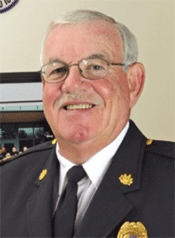 The persistent and pernicious problem of gun violence impacts communities across the United States on a daily basis. Ranging from random shootings and suicides to retaliatory assaults and targeted mass killings, violence committed with firearms universally challenges law enforcement and taxes resources. I believe this insidious problem requires us in law enforcement to lead a new, coordinated, and dedicated response involving citizens, elected leaders, lawmakers, and the entire criminal justice system.
The persistent and pernicious problem of gun violence impacts communities across the United States on a daily basis. Ranging from random shootings and suicides to retaliatory assaults and targeted mass killings, violence committed with firearms universally challenges law enforcement and taxes resources. I believe this insidious problem requires us in law enforcement to lead a new, coordinated, and dedicated response involving citizens, elected leaders, lawmakers, and the entire criminal justice system.
IACP has a long-standing commitment to the eradication of gun violence through many avenues, including our role as a founding law enforcement partner in the national Project Safe Neighborhood (PSN) initiative, which has trained more than 13,500 officers on firearms trafficking interdiction; our ongoing collaboration with the Bureau of Alcohol, Tobacco, Firearms, and Explosives to promote the tracing of all recovered firearms; the diligent work of the IACP Firearms Committee; and our partnership with the Joyce Foundation, which began with the Great Lakes Summit on Gun Violence in 2007. The policy summit findings detailed in the Taking a Stand report brought the issue of gun violence into focus nationally and highlighted practical recommendations for communities to proactively engage in gun violence reduction efforts.
Recent actions by both the IACP and the U.S. Supreme Court are of note as we continue to address gun violence. I am pleased to announce that we are making substantial progress toward creating the IACP Center for the Prevention of Violence against the Police; we have received inaugural support from the Bureau of Justice Assistance and many other federal, state, and local organizations. Though the recent U.S. Supreme Court decision in McDonald v. City of Chicago affirmed the Second Amendment right to possess firearms, it also made clear that reasonable, well-thought-out firearm laws are valid and play a substantial role in protecting citizens from gun violence. Both of these actions relate to a much larger, nationwide gun violence reduction initiative now in development by the IACP with support from the Joyce Foundation.
In order to reduce gun violence across the United States, the IACP needs additional support. This is simply not a fight we can win unless we enlist the resources and interests of the entire law enforcement community. To that end, IACP is working to bring together law enforcement leadership organizations in a National Law Enforcement Partnership to Prevent Gun Violence. In June at IACP headquarters, I convened an initial meeting with the presidents and executive directors of 10 key law enforcement organizations to discuss the problem and share information regarding the various efforts already under way to address gun violence.
There is clear consensus on the urgency of the problem and the need to stand together to promote both officer and community safety. Since all involved recognized the power and influence these leadership organizations represent and the unprecedented potential of a national partnership, the discussion quickly turned to a strategy for collaboration. A center point of this strategy is the development of a Statement of Principles, which will serve as a foundation for our joint efforts to reduce gun violence and promote safer communities. We are grateful to the following organizations for their vision and commitment to this partnership: the Commission on Accreditation for Law Enforcement Agencies, the Hispanic American Police Command Officers Association, the International Association of Campus Law Enforcement Administrators, the Major Cities Chiefs, the National Association of Women Law Enforcement Executives, the National Organization of Black Law Enforcement Executives, the National Sheriffs’ Association, the Police Executive Research Forum, and the Police Foundation.
The partner organizations stand together in support of this Statement of Principles and are developing an agenda to realize these key principles:
1. The level of gun violence in the United States, specifically firearm-related injuries and deaths including homicides, suicides, and accidental shootings, is unacceptable and demands immediate attention.
2. As law enforcement organizations, we believe the level and lethality of gun violence directed at police officers requires an organized and aggressive response from policy makers at the federal, state, and local levels.
3. Elected officials must commit to closing gaps in the current regulatory system, including those that enable felons, minors, persons with mental illness, and other prohibited persons to access firearms, and those that allow the trafficking of illegal guns.
4. Law enforcement plays a central and critical role in preventing gun violence and solving crimes. Effective strategies for the strict enforcement of laws concerning the illegal possession, trafficking, and criminal use of firearms are vital and need to be supported by data, research, technology, training, and best practices.
5. Because the public’s health and safety depends on the efforts of law enforcement, agencies must have resources sufficient to prioritize the protection of officers and communities against illegal guns and firearm violence.
6. The crisis of gun violence in our country necessitates a sustained, coordinated, and collaborative effort involving citizens, elected officials, law enforcement, and the entire criminal justice system.
The unacceptable level of gun violence needs the collective response and efforts of this newly created National Law Enforcement Partnership to Prevent Gun Violence. I am encouraged by our collective potential to reduce the violence tearing at our communities. While the partnership can play a significant role, I urge you to become involved from your individual, organizational, and state roles. We will need law enforcement leaders and committed citizens everywhere to embrace this effort and join with us in taking a stand against gun violence. ■
Please cite as:
Michael J. Carroll, “Coordinated Effort Required to Curb Gun Violence,” President’s Message, The Police Chief 77 (September 2010): 6,
http://www.nxtbook.com/nxtbooks/naylor/CPIM0910/index.php#/6 (insert access date).


